Foot Locker Bundle
Can Foot Locker's "Lace Up Plan" Secure Its Future?
Foot Locker, a global leader in athletic footwear and apparel, is navigating a dynamic retail landscape with its ambitious growth strategy. Founded in 1974, the company has evolved from its Kinney shoe division roots to a diverse portfolio of store formats, including Foot Locker and Champs Sports. With approximately 2,410 stores across 26 countries, the company's future prospects hinge on its ability to adapt and innovate.
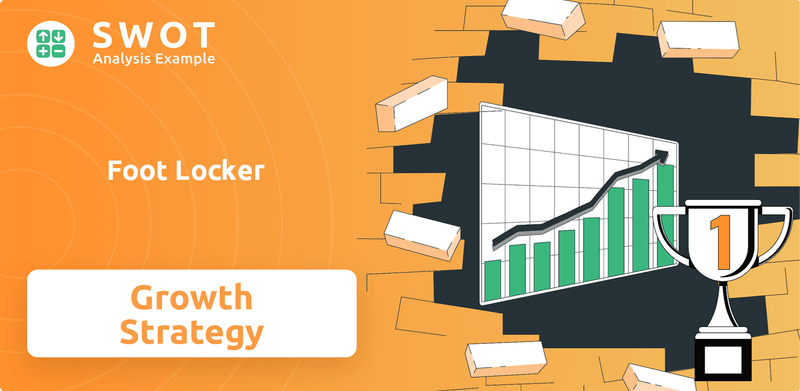
Foot Locker's "Lace Up Plan," launched in March 2023, is central to its Foot Locker SWOT Analysis. The plan focuses on enhancing in-store experiences, boosting digital capabilities, and forging stronger brand partnerships to drive sustainable growth. Understanding the Foot Locker growth strategy is crucial for investors and analysts assessing the Foot Locker company's potential within the footwear retail market and broader sports apparel industry, as the company aims to solidify its position through initiatives like Foot Locker expansion plans 2024 and strategic investments in its e-commerce platform analysis.
How Is Foot Locker Expanding Its Reach?
The 'Lace Up Plan' outlines the Foot Locker growth strategy, emphasizing expansion and optimization. This strategy focuses on enhancing the retail footprint, entering new markets, and strengthening brand partnerships within the footwear retail market and sports apparel industry.
A key component of the strategy involves the rollout of 'Reimagined' store concepts, designed to provide an elevated shopping experience. These initiatives are part of a broader effort to drive growth and improve the company's position in the competitive retail business analysis.
The company is actively implementing several expansion initiatives to boost its future prospects. These include new store formats, renovations, and strategic partnerships to adapt to evolving consumer behaviors within the footwear industry.
In 2024, eight 'Reimagined' stores opened across North America, Europe, and Asia-Pacific. The plan is to accelerate this rollout, targeting 80 locations by 2025. These stores, such as the one in Willowbrook Mall, Wayne, N.J., incorporate sustainability and digital fixtures.
Foot Locker is renovating a significant portion of its global store network. The goal is to refresh approximately two-thirds of its global Foot Locker and Kids Foot Locker stores by the end of 2025. By the end of 2025, the company will have renovated 800 stores over a two-and-a-half-year period.
Foot Locker is optimizing its store fleet by closing around 400 underperforming mall-based stores by 2026. In 2025, this includes 110 closures and 20 new openings. This aims to create a stronger store base.
The company is converting select Asian markets to a licensing model. Operations in Greece and Romania will be transferred to Fourlis Group by mid-2025. Stores are being closed in South Korea, Denmark, Norway, and Sweden to streamline international operations.
Foot Locker is strengthening its brand partnerships to enhance its market presence. These partnerships include an expanded multiyear collaboration with the NBA in Europe, involving youth basketball clinics and fan activations. A multi-year partnership with the Chicago Bulls was also announced in October 2024.
- The NBA partnership includes youth basketball clinics and fan activations.
- The Chicago Bulls partnership, announced in October 2024, aims to increase brand visibility.
- These partnerships are crucial for customer acquisition strategies.
- These initiatives are part of Foot Locker's broader sustainability initiatives.
Foot Locker SWOT Analysis
- Complete SWOT Breakdown
- Fully Customizable
- Editable in Excel & Word
- Professional Formatting
- Investor-Ready Format
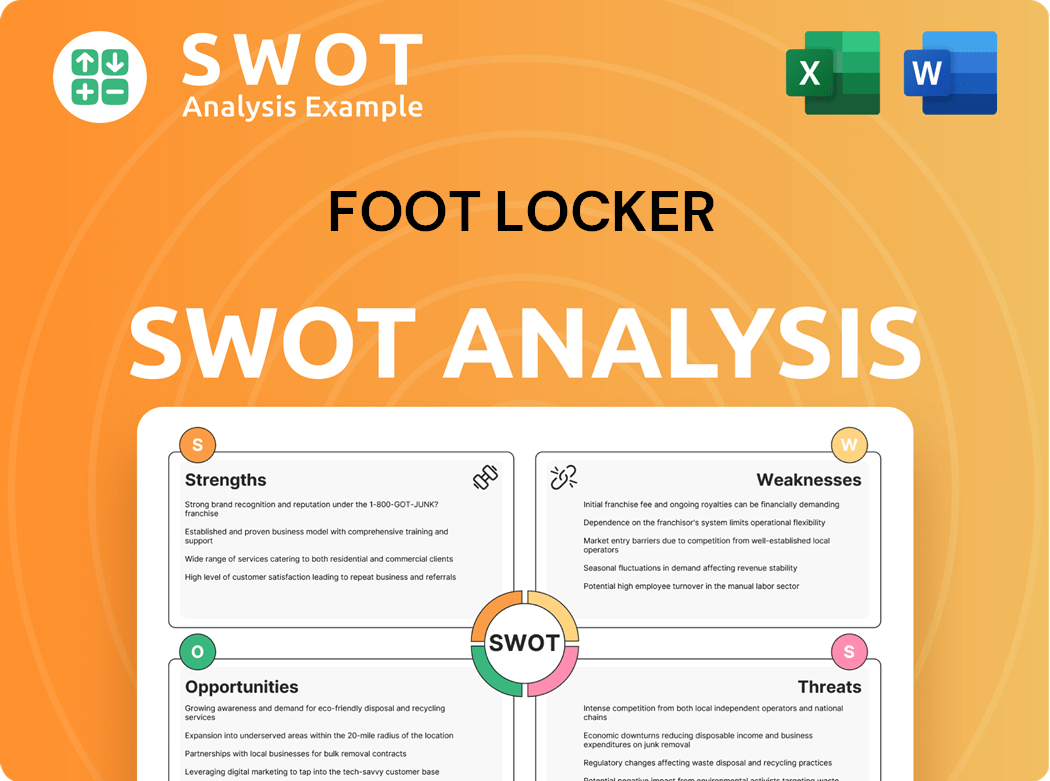
How Does Foot Locker Invest in Innovation?
The retail landscape is constantly evolving, and understanding customer needs and preferences is crucial for success in the footwear retail market. Consumers are increasingly seeking seamless shopping experiences, whether they're browsing online or visiting a physical store. They also value personalized interactions and exclusive offerings that enhance their engagement with brands.
In the sports apparel industry, customers are looking for a blend of style, performance, and value. They want access to the latest trends, innovative products, and convenient ways to shop. Furthermore, loyalty programs and digital engagement are becoming key drivers of customer retention and brand loyalty.
As the Target Market of Foot Locker evolves, the company must adapt to meet these changing demands. This involves leveraging technology, enhancing in-store experiences, and building strong customer relationships.
Foot Locker is heavily invested in digital transformation as a core part of its Foot Locker growth strategy. This involves enhancing its e-commerce platform and improving the overall online shopping experience. The company aims to increase digital penetration to approximately 25% by 2026.
In late 2024, Foot Locker launched a new mobile app in the US, offering a faster and more modern shopping experience. The app features richer content and improved launch features. New mobile apps for Champs Sports and Kids Foot Locker were also launched in Q1 2025.
The 'Best-in-Class Omni' pillar is a key part of Foot Locker's 'Lace Up Plan,' focusing on a seamless omnichannel experience. This strategy integrates online and in-store experiences to provide customers with flexibility and convenience. The company is working to fulfill a large number of digital orders directly from stores.
Foot Locker is introducing 'Reimagined' concept stores to enhance the in-store experience. These stores feature dynamic digital fixtures and technological advancements. They aim to create an immersive brand experience for customers and provide staff with advanced tools.
Investments in inventory accuracy and vendor relationships are central to Foot Locker's transformation. This enables the company to fulfill digital orders directly from stores. This approach significantly reduced cancelled and rejected orders in 2024.
The enhanced FLX Rewards Program was relaunched in the United States in 2024. The loyalty sales capture rate increased to 33% in 2024 from 23% in 2023, with a target of 50% loyalty penetration by 2026. This program is designed to increase customer engagement.
Foot Locker's innovation strategy focuses on leveraging technology to improve customer experience and operational efficiency. This includes digital enhancements, in-store innovations, and loyalty program improvements. These initiatives are crucial for the company's future prospects and sustained growth in the competitive retail business analysis.
- E-commerce Enhancements: Improving website merchandising, search, and navigation to boost online sales.
- Mobile App Development: Launching new mobile apps for a faster and more engaging shopping experience.
- Reimagined Store Concepts: Implementing dynamic digital fixtures and advanced technology in stores.
- Omnichannel Fulfillment: Utilizing store inventory to fulfill online orders, reducing order cancellations.
- Loyalty Program Enhancements: Relaunching and improving the FLX Rewards Program to increase customer engagement.
Foot Locker PESTLE Analysis
- Covers All 6 PESTLE Categories
- No Research Needed – Save Hours of Work
- Built by Experts, Trusted by Consultants
- Instant Download, Ready to Use
- 100% Editable, Fully Customizable
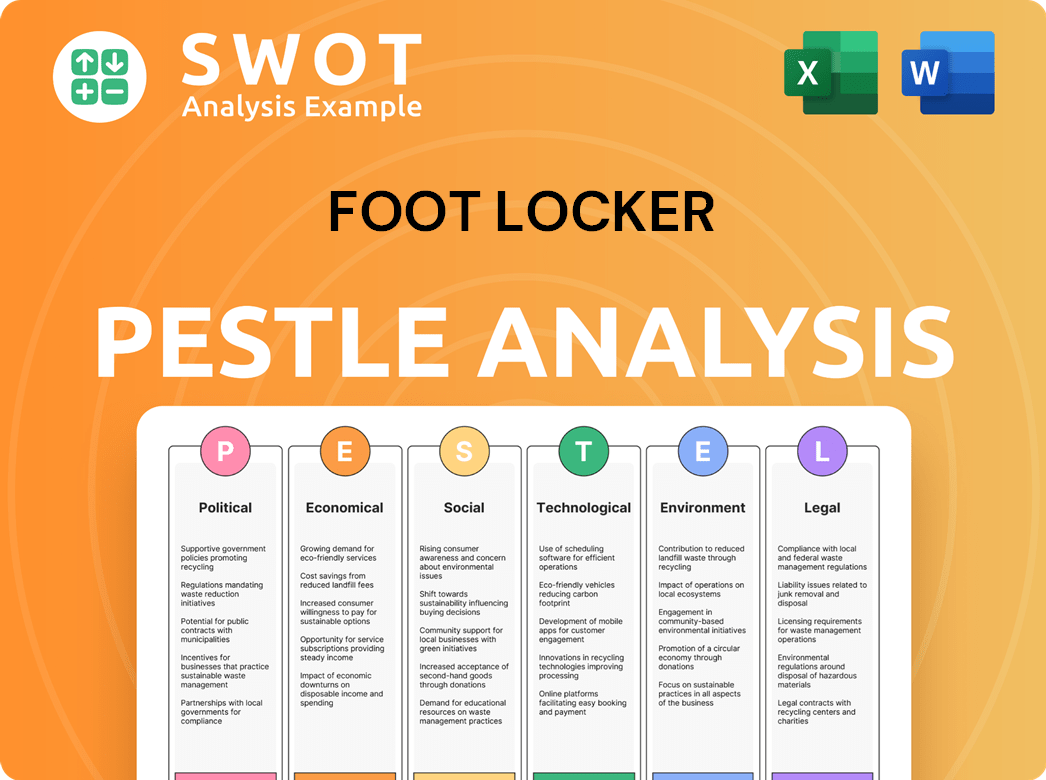
What Is Foot Locker’s Growth Forecast?
The financial outlook for Foot Locker, a key player in the footwear retail market, is largely shaped by its 'Lace Up Plan'. This strategic initiative is designed to boost comparable sales, improve gross margins, and generate positive free cash flow. The company's future prospects hinge on the successful execution of this plan within the sports apparel industry.
For fiscal year 2025, Foot Locker anticipates a sales performance that could range from a decrease of 1.0% to an increase of 0.5%. This projection indicates a period of potential stabilization and modest growth. The company's ability to navigate the competitive landscape will be crucial in achieving these targets, as highlighted in a recent analysis of Owners & Shareholders of Foot Locker.
The company's financial health is also reflected in its gross margin projections, which are expected to be between 29.3% and 29.7% for 2025. Furthermore, the EBIT margin is estimated to fall within the range of 2.6% to 3.1%. Foot Locker's long-term goal is to achieve an 8.5-9% EBIT margin by 2028, demonstrating a commitment to sustained profitability.
In fiscal 2024, Foot Locker saw a return to positive comparable sales growth of 1.4%. The Foot Locker and Kids Foot Locker banners led with 3.1% growth. This indicates a strengthening of the company's market position and effective strategies in the retail business analysis.
Foot Locker achieved a gross margin expansion of 120-bps in 2024, signaling improved profitability. This increase reflects efficient cost management and strategic pricing within the footwear retail market.
Foot Locker reported earnings per share from continuing operations of $0.19 and Non-GAAP earnings per share of $1.37 in 2024. These figures provide insights into the company's financial health and its ability to generate returns.
Free cash flow returned to positive in 2024, a significant improvement from the prior two years. This positive shift indicates better financial flexibility and the ability to invest in future growth.
Despite a net loss of $363 million in Q1 2025, compared to a net income of $8 million in Q1 2024, the company's strategic initiatives are expected to improve profitability. Foot Locker aims for cost savings of $60 million to $70 million in 2025 as part of a larger $350 million cost optimization plan. S&P Global Ratings forecasts Foot Locker's adjusted EBITDA margin to improve to 13.3% in 2025, up from about 13% in 2024.
Foot Locker Business Model Canvas
- Complete 9-Block Business Model Canvas
- Effortlessly Communicate Your Business Strategy
- Investor-Ready BMC Format
- 100% Editable and Customizable
- Clear and Structured Layout
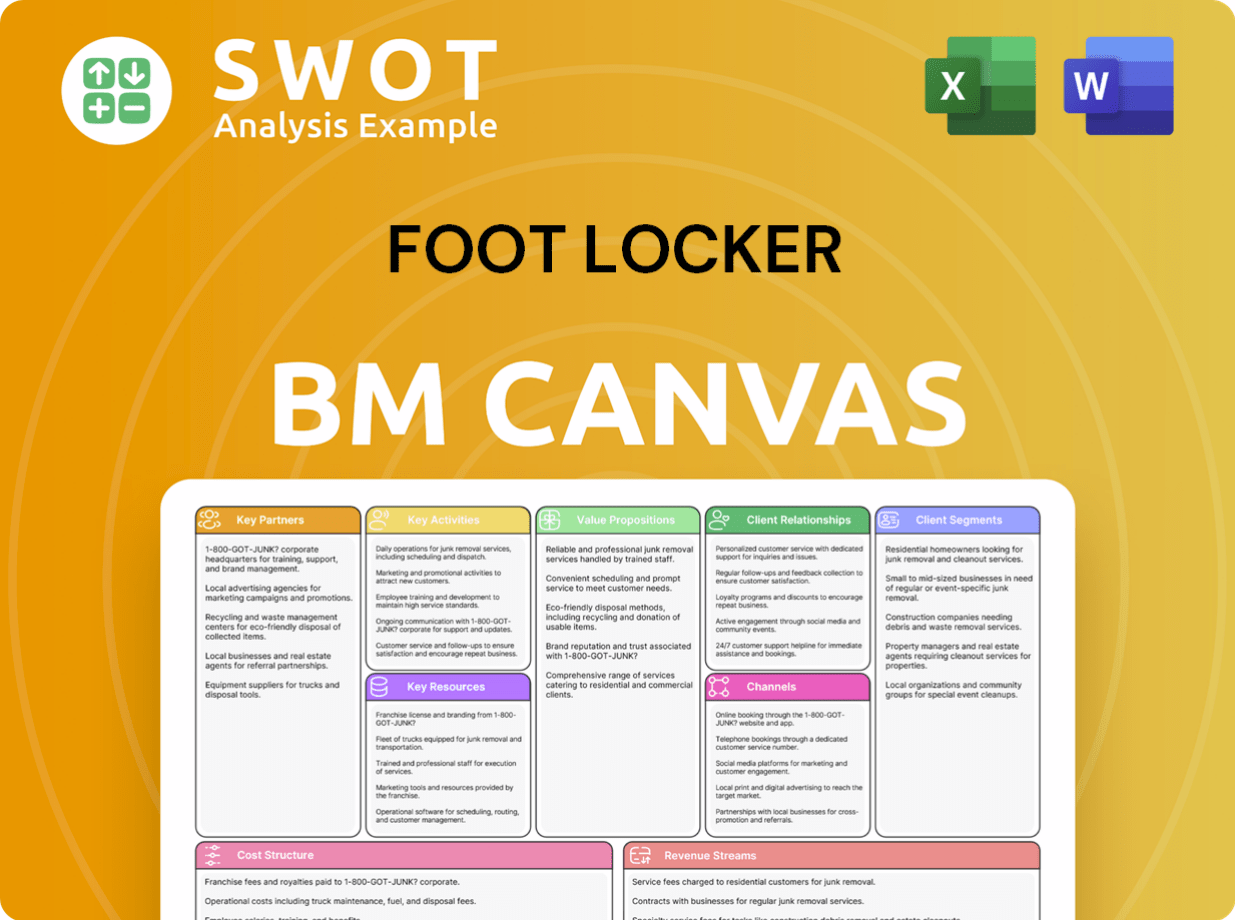
What Risks Could Slow Foot Locker’s Growth?
The success of the Foot Locker company hinges on its ability to navigate a complex landscape of risks and obstacles. These challenges span competitive pressures, shifts in consumer behavior, and macroeconomic uncertainties, all of which can impact the company's growth trajectory. Understanding these potential pitfalls is crucial for assessing the firm's future prospects within the footwear retail market and the broader sports apparel industry.
One of the primary concerns for Foot Locker is the intense competition within the retail business analysis. With rivals like Dick's Sporting Goods and JD Sports aggressively vying for market share, Foot Locker must continually innovate and adapt. Moreover, the shift by major suppliers, such as Nike, towards direct-to-consumer (DTC) sales poses a significant threat, potentially reducing merchandise allocations to Foot Locker and impacting revenue streams. This dynamic underscores the importance of a robust Foot Locker growth strategy.
Economic headwinds and market trends also represent significant risks. Inflation and potential recession concerns could curb consumer spending on discretionary items, directly affecting Foot Locker's sales. Furthermore, the company faces challenges in international markets, as seen by sales declines in the Asia-Pacific region during fiscal Q4 2024. These factors highlight the need for strategic adaptability and efficient operational management to mitigate risks and ensure sustainable growth for the Foot Locker company.
The footwear retail market is highly competitive, with rivals like Dick's Sporting Goods and JD Sports. Nike's DTC strategy reduces merchandise for third-party retailers. This environment necessitates constant innovation and strategic adaptation for Foot Locker.
Nike's shift toward DTC sales is a significant threat to Foot Locker. This can lead to reduced merchandise allocations. Nike's influence on Foot Locker remains a key factor, with approximately 60% of its exposure in 2024.
Market trends and economic factors, including inflation and potential recession, can influence consumer spending. These conditions directly impact sales of discretionary items. Foot Locker must navigate these challenges to maintain financial performance.
Foot Locker faces struggles in international markets, with sales dropping in regions like Asia-Pacific by -7.6% in fiscal Q4 2024. Exits from markets like South Korea and operational transfers in Greece and Romania reflect these difficulties. These international challenges impact Foot Locker's future prospects.
Foot Locker relies heavily on a few key suppliers, primarily Nike, which accounts for approximately 70% of its total product inventory. This dependence exposes the company to price increases and supply chain disruptions. The company has to manage inventory supply chain disruption risks of 15.6%.
The apparel segment continues to underperform, with mid-teen sales declines. The apparel segment faces lagging innovation and stiff competition. This underperformance affects overall revenue and profitability.
Foot Locker addresses these risks through diversification, investing in omnichannel capabilities, and focusing on inventory accuracy and vendor collaboration. The company has implemented cost-saving measures, although some analysts express concern that excessive cost-cutting could hinder investments in technology and brand building. Currency fluctuations are also a concern, potentially hurting profitability and adding uncertainty to the 2025 revenue outlook, with foreign currency headwinds expected to negatively impact 2025 revenues by approximately 100 basis points.
The company's financial performance is heavily influenced by the supply chain, with potential price increases of 8-12% annually. The apparel segment continues to underperform, with mid-teen sales declines, lagging innovation, and stiff competition. The company has exited several international markets, including South Korea, Denmark, Norway, and Sweden by mid-2025. The company's efforts in cost-saving measures could potentially hinder investments in technology and brand building.
Foot Locker Porter's Five Forces Analysis
- Covers All 5 Competitive Forces in Detail
- Structured for Consultants, Students, and Founders
- 100% Editable in Microsoft Word & Excel
- Instant Digital Download – Use Immediately
- Compatible with Mac & PC – Fully Unlocked
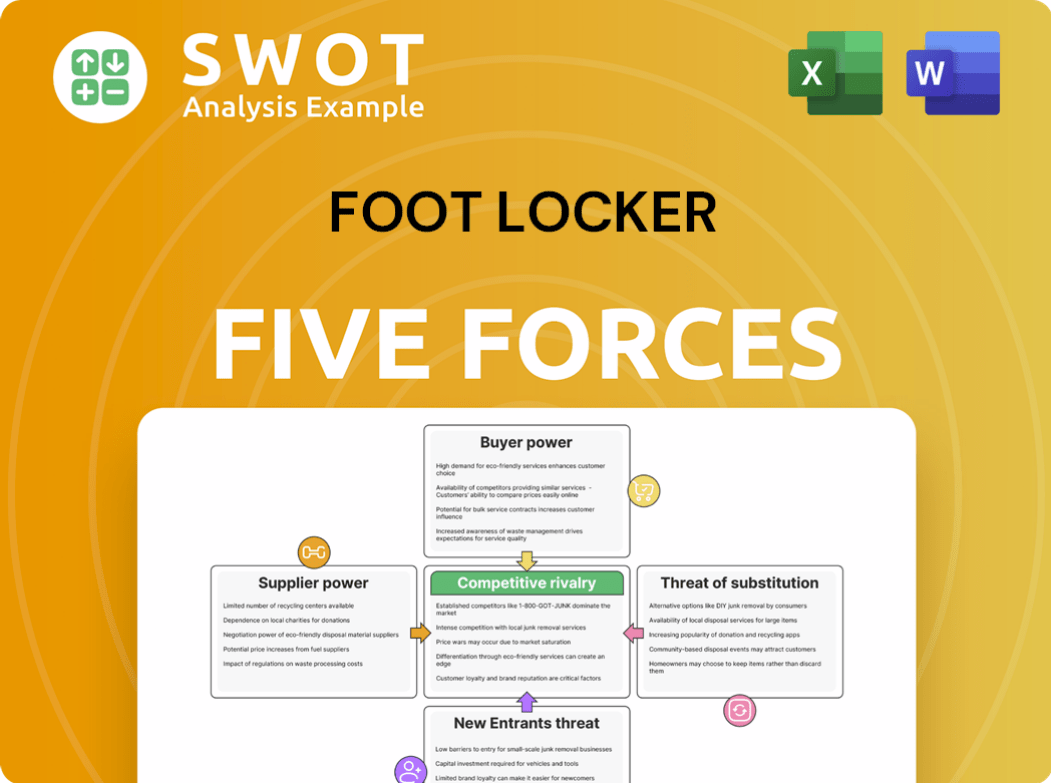
Related Blogs
- What are Mission Vision & Core Values of Foot Locker Company?
- What is Competitive Landscape of Foot Locker Company?
- How Does Foot Locker Company Work?
- What is Sales and Marketing Strategy of Foot Locker Company?
- What is Brief History of Foot Locker Company?
- Who Owns Foot Locker Company?
- What is Customer Demographics and Target Market of Foot Locker Company?
Disclaimer
All information, articles, and product details provided on this website are for general informational and educational purposes only. We do not claim any ownership over, nor do we intend to infringe upon, any trademarks, copyrights, logos, brand names, or other intellectual property mentioned or depicted on this site. Such intellectual property remains the property of its respective owners, and any references here are made solely for identification or informational purposes, without implying any affiliation, endorsement, or partnership.
We make no representations or warranties, express or implied, regarding the accuracy, completeness, or suitability of any content or products presented. Nothing on this website should be construed as legal, tax, investment, financial, medical, or other professional advice. In addition, no part of this site—including articles or product references—constitutes a solicitation, recommendation, endorsement, advertisement, or offer to buy or sell any securities, franchises, or other financial instruments, particularly in jurisdictions where such activity would be unlawful.
All content is of a general nature and may not address the specific circumstances of any individual or entity. It is not a substitute for professional advice or services. Any actions you take based on the information provided here are strictly at your own risk. You accept full responsibility for any decisions or outcomes arising from your use of this website and agree to release us from any liability in connection with your use of, or reliance upon, the content or products found herein.